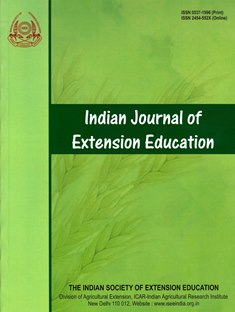Agricultural Productivity through Rural Assets: Evaluating MGNREGA’s Role in Boosting Agricultural Performance in India
DOI:
https://doi.org/10.48165/IJEE.2025.61304Keywords:
Agricultural productivity, MGNREGA, Rural public infrastructure, Random-fixed effect, AgriculturalAbstract
The study evaluated the agricultural productivity effects of rural infrastructure investments and employment provision under the Mahatma Gandhi National Rural Employment Guarantee Act (MGNREGA) in India. The study assesses how public works, such as land development, micro-irrigation, drought-proofing, and rural connectivity, support key agricultural outcomes, including cultivated area, crop yield, and total production. Using state-level panel data from 2016 to 2023 and applying both fixed and random effects models, the study rigorously accounts for state-specific heterogeneity and time-invariant factors, ensuring unbiased and policy-relevant estimates of MGNREGA’s impact on agriculture. The empirical findings demonstrate robust positive effects of MGNREGA-facilitated assets, particularly land development, drought-proofing, water conservation, and micro-irrigation, on key agricultural performance indicators. Notably, localised employment generation, as indicated by person-days of employment, emerges as a critical enabler of enhanced productivity. These findings highlight the potential of MGNREGA not merely as a welfare initiative but as a catalytic policy tool for agricultural enhancement. The research underscores the value of integrating rural employment schemes with agronomic needs to improve productivity, stabilise output, and support sustainable rural livelihoods in India’s agrarian economies.
Downloads
References
Nantha, K. H., Garg, K. K., Moses, D. S., Patil, M. D., Sawargaonkar, G. L., Kamdi, P. J., Malve, S., Sudi, R., Raju, K. V., & Wani, S. P. (2021). Impact of natural resource management interventions on water resources and environmental services in different agroecological regions of India. Groundwater for Sustainable Development, 13. https://doi.org/10.1016/j.gsd.2021.100574
Baltagi, B. H. (2014). Panel data and difference-in-differences estimation. In Encyclopedia of Health Economics (pp. 425–433). Elsevier. https://doi.org/10.1016/B978-0-12-375678-7.00720-3
Bharne, S., Yadav, P., & Jatav, S. (2025). Effect of crop insurance and employment support on agricultural households’ well-being: Evidence from India. Indian Journal of Extension Education, 61(1). https://doi.org/10.48165/IJEE.2025.61112
Deininger, K., & Liu, Y. (2019). Heterogeneous welfare impacts of national rural employment guarantee scheme: Evidence from Andhra Pradesh, India. World Development, 117, 98–111. https://doi.org/10.1016/j.worlddev.2018.12.014
Dettori, J. R., Norvell, D. C., & Chapman, J. R. (2022). Fixed-effect vs random-effects models for meta-analysis: 3 points to consider. Global Spine Journal, 12(7), 1624–1626. https://doi.org/10.1177/21925682221110527
Drèze, J., & Khera, R. (2017). Recent social security initiatives in India. World Development, 98, 555–572. https://doi.org/10.1016/j.worlddev.2017.05.035
Gautam, S. (2024). Understanding Cobb-Douglas production function in agricultural economics. Journal of Technology & Innovation, 4(2), 75–78. https://doi.org/10.26480/jtin.02.2024.75.78
GoI. (2024). Economic Survey 2023-24. Retrieved from https://www.indiabudget.gov.in/budget2024-25/economicsurvey/index.php
Imbert, C., & Papp, J. (2015). Labour market effects of social programs: Evidence from India’s employment guarantee. American Economic Journal: Applied Economics, 7(2), 233–263. https://doi.org/10.1257/app.20130401
Jatav, S. S., & Singh, N. P. (2023). Determinants of climate change adaptation strategies in Bundelkhand region, India. Indian Journal of Extension Education, 59(2), 5–9.
Jiragal, I., Ganesamoorthi, S., Khatoon, M., Mohankumar, T. L., & Narayanaswamy, C. (2025). Food, economic, and livelihood security of farmers under PMFBY in Kolar, Karnataka. Indian Journal of Extension Education, 61(2), 40–44. https://doi.org/10.48165/IJEE.2025.61208
Mohanakumar, S., & Vipin Kumar, R. (2018). Rural labour market and farmers under MGNREGA in Rajasthan. Indian Journal of Labour Economics, 61(1), 131–155. https://doi.org/10.1007/s41027-018-0125-4
MoRD. (2024, April). MGNREGA MIS Dashboard. Retrieved April 2025, from https://nreganarep.nic.in/netnrega/misreport4.aspx
Nain, M., Singh, R., & Mishra, J. (2024, January-March). Developing model for diffusion of farmers’ innovations for maximizing farm income: Indian Agricultural Research Institute experiences. Indian Journal of Extension Education, 60(1), 105-110. https://doi.org/10.48165/IJEE.2024.60120
Narayanan, S., Naraparaju, K., & Gerber, N. (2019). Synergies in social protection: Impacts of India’s MGNREGA and public distribution system on the health and nutrition of women and children. SSRN Electronic Journal. https://doi.org/10.2139/ssrn.3513358
Patel, R. R. (2024). Addressing rural poverty, efficacy of MGNREGA and migration against agricultural productivity: Case of Kalahandi, India. Journal of Poverty, 1–25. https://doi.org/10.1080/10875549.2024.2379783
Reddy, T. P., & Babu, V. S. (2018). Impact of MGNREGS on rural labour markets and agriculture: A study of Madhya Pradesh. In Springer Proceedings in Business and Economics (pp. 187–205). https://doi.org/10.1007/978-3-319-99555-7_12
Rodriguez, Z. (2022). The power of employment: Effects of India’s employment guarantee on women empowerment. World Development, 152, 105803.
Shaba, S. A., & Alam, M. M. (2024). Farmers’ satisfaction with agricultural extension: A service quality-based assessment. Indian Journal of Extension Education, 60(3), 1–6. https://doi.org/10.48165/IJEE.2024.60301
Shah, M. (2016). Should India do away with the MGNREGA? The Indian Journal of Labour Economics, 59(1), 125–153. https://doi.org/10.1007/s41027-016-0044-1
Sheahan, M., Liu, Y., Barrett, C. B., & Narayanan, S. (2018). Preferential resource spending under an employment guarantee: The political economy of MGNREGS in Andhra Pradesh. World Bank Economic Review, 32(3), 551–569. https://doi.org/10.1093/wber/lhw044
UPAg. (2024, April). Unified Portal for Agricultural Statistics (UPAg). Retrieved April 2025, from https://www.upag.gov.in/all-dashboards
Vogelsang, T. J. (2012). Heteroskedasticity, autocorrelation, and spatial correlation robust inference in linear panel models with fixed effects. Journal of Econometrics, 166(2), 303–319.
Yadav, P., & Ghosh, S. (2023). Effectiveness of adaptation mechanisms of farmers and its determinants in flood prone area of Bihar. Indian Journal of Extension Education, 59(3), 32–37.
Downloads
Published
Issue
Section
License

This work is licensed under a Creative Commons Attribution-NonCommercial-NoDerivatives 4.0 International License.

